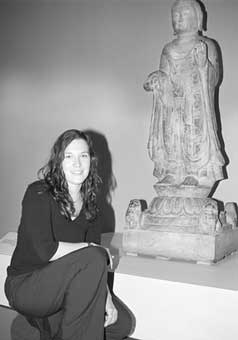                                                |
|
Local
curator walks the Silk Road
 |
|
Photo by Lauren Heaton
Laura Bergman, Dayton Art Institute curator, next to an ancient
buddha included in the museum’s current exhibit, ‘Glory
of the Silk Road: Art from Ancient China’.
|
Local resident Laura
Bergman likes to share the things she knows about art history. From the
way her eyebrows rise when she speaks of the ceramic groomsman from ancient
Turfan and the gilt bronze Buddha from Xi’an, it is obvious she once
was a teacher.
Now, as a curator at the Dayton Art Institute, she could talk forever
about the museum’s current exhibit “Glory of the Silk Road:
Art from Ancient China.”
“The thing that is most poignant about the Silk Road,” she said,
“is how it shows that the centuries of the Tang Dynasty were the
most open times of Chinese history in their appreciation of other cultures.”
Most of the 176 items in the exhibit were unearthed from three excavation
areas in China, Xinjiang, Ganxu Corridor and Xi’an, according to
a release prepared by the museum’s Asian art curator, Li Jian. They
include not only sixth to ninth century jade, silk tapestries and bronze
statues commonly associated with ancient China, but also many treasured
artifacts of gold, glass and precious stones from India, Greece and the
Roman Empire. This is the first time most of them have been viewed in
the United States.
People of the East and the West each prized the other’s technological
innovations and respected the differences in philosophy and religious
practice, Bergman said. The Silk Road made possible the exchange not only
of goods but of Buddhism, Christianity, astrology, medicine, music and
dance.
“The greatest
thing about the Silk Road was about the tolerance and the sharing of cultures,”
she said. “At a time like this I wish we had more of that going on.”
Bergman knows that change starts with the youth. While she was working
at the museum, she earned a teaching certificate in art education from
Antioch University McGregor. In the fall of 2001 she student-taught mostly
seventh graders at the McKinney School with art teacher Carla Steiger-Meister.
And when her time with the museum ends in the fall, Bergman intends to
resume teaching full time.
“I feel that learning art history is learning history, music and
science through the eyes of art,” she said. “Art history is
as important as the activity of art, and tying them together helps bring
cultures together.”
As she helped curate the exhibit, which was four years in the making,
Bergman said she learned a lot about Eastern art and culture. The 7,000-mile
trade route became known as the Silk Road because the most heavily traded
item along the way was silk, then equal to its weight in gold. But so
many other works of art tell stories of the people from one side of the
mountainous central Asian desert to the other.
The Chinese female figurines dressed in men’s clothing and on horseback
and dating back to the Tang Dynasty suggest that women at that time were
relatively free in society. The arms of a Chinese doll from Turfan wearing
Iranian clothing and stuffed with recycled pawn tickets from the same
period shows intercultural exchange and indicates that paper was probably
scarce at that time. Sculptures of jovial Sogdian (modern day Iran and
Iraq) groomsmen dancing and on horseback suggest a perception of Middle
Eastern people as celebratory and good spirited.
“When you think of this period a lot of people think of ancient Rome
and Greece,” Bergman said. “The more I learn about this period
I realize this was such a thriving culture that equalled it.”
This is the first time many of these works of art will have left China,
Bergman said. The Midwest has never seen a collection of this extent,
and scholars from around the world have contacted the DAI for information,
wanting to see the exhibit, she said.
Bergman for one thinks it is phenomenal that these pieces have survived
for so long and have traveled half way around the world for display in
our area. The “Silk Road” opened in February at the DAI and
will remain on display until May 11, after which the exhibit travels to
Memphis.
With a bachelors degree in art history from Ohio University, Bergman started
working at the Art Institute as a server in the museum’s cafe. She
soon worked her way into the operation as an art handler, unpacking and
cleaning famous paintings by Picasso and Cézanne for the French
Impressionists exhibit and huge glass sculptures for the recent Chihuly
exhibit. She was working in cataloging and storage when Li Jian needed
help getting her show together.
“When I began I didn’t really know what I was getting into,
but I’m really glad I did because it’s been an amazing experience,”
Bergman said.
Bergman hasn’t forgotten the path she set out on when she decided
to work primarily in education.
“I love working with art,” she said, “but it’s also
nice to be able to share what you’ve learned.”
She has a great story to share with her future students.
—Lauren
Heaton
|



